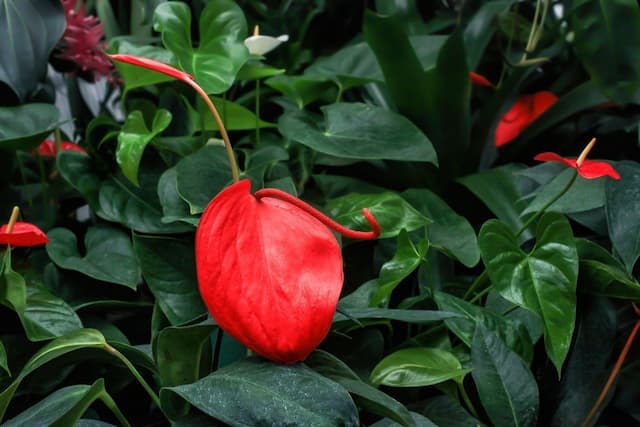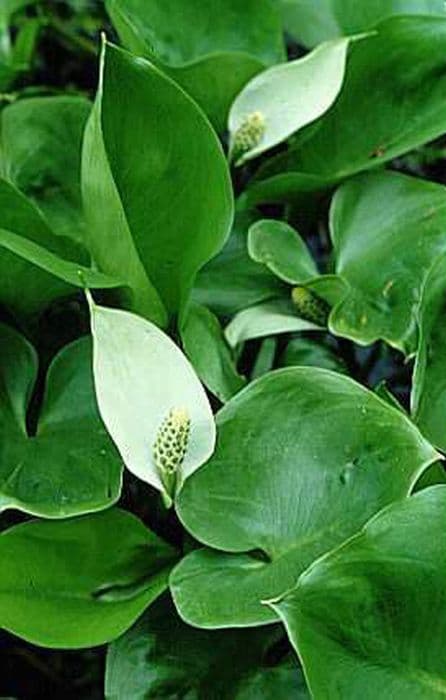Calla Lily 'Flamingo' Zantedeschia aethiopica 'Flamingo' (PBR)

ABOUT
The plant known as 'Flamingo' is a cultivar with a striking appearance, characterized by its vibrant and elegant blooms. The flowers have a unique shape, resembling a funnel with a flared mouth, often likened to the spout of a graceful pitcher. Their color is a soft yet striking pink, which gradually transitions to a paler hue near the edges, providing a delicate contrast. The flowers emerge from a leafless stalk, which gives them a prominent and unobstructed display. Surrounding these blooms are arrow-shaped leaves that have a rich, glossy green color and a slightly wavy texture that adds to the overall lushness of the foliage. The leaves create a dense clump, offering a verdant backdrop to the pastel floral display. This plant typically exudes a refined and exotic aesthetic and is a favored choice for ornamental purposes in gardens and floral arrangements.
About this plant
 Names
NamesFamily
Araceae
Synonyms
Flamingo Flower, Flamingo Lily, Flamingo Calla Lily
Common names
Zantedeschia aethiopica 'Flamingo' (PBR).
 Toxicity
ToxicityTo humans
The Calla Lily contains compounds that are toxic to humans if ingested. Symptoms of poisoning can include irritation of the mouth and throat, nausea, vomiting, and diarrhea. Ingesting parts of the plant can lead to serious health issues due to the plant's oxalate crystals, which can cause swelling and a burning sensation.
To pets
The Calla Lily is also toxic to pets, including dogs and cats. Symptoms of poisoning in pets can mirror those in humans, such as drooling, vomiting, difficulty swallowing, and oral irritation. The presence of calcium oxalate crystals in the plant can lead to severe symptoms and potentially fatal consequences if not treated promptly.
 Characteristics
CharacteristicsLife cycle
Perennials
Foliage type
Evergreen
Color of leaves
Green
Flower color
Pink
Height
2 feet 24 inches (60 cm)
Spread
2 feet 24 inches (60 cm)
Plant type
Herb
Hardiness zones
8
Native area
South Africa
Benefits
 General Benefits
General Benefits- Ornamental Value: The Zantedeschia aethiopica 'Flamingo', commonly known as Calla Lily 'Flamingo', has striking pink spathe-shaped flowers which can serve as a focal point in gardens or floral arrangements.
- Easy to Grow: This plant is well-regarded for its ease of cultivation. It can thrive in a range of conditions including boggy soils, making it suitable for many gardeners.
- Low Maintenance: Calla Lily 'Flamingo' requires minimal care once established, making it a convenient choice for busy gardeners.
- Long Blooming Period: This variety of Calla Lily generally offers a long flowering season, providing vibrant color for an extended period.
- Attracts Wildlife: The flowers can attract beneficial insects such as bees, which are important for pollination in the garden.
- Great for Cut Flowers: The blooms are long-lasting even when cut, making them perfect for bouquets and floral displays.
- Water Garden Suitability: Because of its tolerance for moist soil, it is ideal for water gardens or pond margins.
- Versatility in Landscaping: It can be used in a variety of garden settings, including borders, beds, and containers, adding versatility to landscape design.
- Seasonal Interest: Calla Lily 'Flamingo' offers seasonal interest from its flowering period into the fall as the foliage remains visually appealing.
 Medical Properties
Medical PropertiesThis plant is not used for medical purposes.
 Air-purifying Qualities
Air-purifying QualitiesThis plant is not specifically known for air purifying qualities.
 Other Uses
Other Uses- Biodegradable plant pot: The robust leaves of the Calla Lily can be shaped and dried to form a natural and biodegradable container for small plants or seedlings.
- Natural pest repellent: When crushed, the leaves emit a scent that can repel certain insects, making it a natural choice for an organic pest management strategy in gardens.
- Floral art and design: Due to their unique shape and vivid color, Calla Lily flowers are often used in floral art, including the creation of living sculptures and botanical jewelry.
- Photography subject: The Calla Lily's beautiful and unique form makes it a popular subject for photographers looking to capture the intricacies of natural shapes and colors.
- Educational model: The flower's structure is used to teach botany and plant anatomy, showcasing the spathe and spadix to students and plant enthusiasts.
- Water garden feature: Being a water-loving plant, the Calla Lily can be used to adorn water gardens or ponds, adding an exotic and decorative touch to aquatic landscaping.
- Eco-friendly dye: The pigments in Calla Lily petals can be extracted and used as a natural dye for fabrics, offering an environmentally friendly alternative to synthetic dyes.
- Culinary decoration: The flowers, when confirmed non-toxic and grown organically, can be used as a delicate and elegant garnish for gourmet dishes.
- Wedding confetti: Dried petals of the Calla Lily can be used as natural, biodegradable confetti for eco-conscious wedding celebrations.
- Seasonal wreaths: Dried Calla Lilies are often incorporated into festive wreaths and seasonal decorations thanks to their durability and aesthetic appeal.
Interesting Facts
 Feng Shui
Feng ShuiThe Calla Lily is not used in Feng Shui practice.
 Zodiac Sign Compitability
Zodiac Sign CompitabilityThe Calla Lily is not used in astrology practice.
 Plant Symbolism
Plant Symbolism- Purity and innocence: The Zantedeschia aethiopica, commonly known as Calla Lily 'Flamingo', often symbolizes purity and innocence due to its elegant and immaculate appearance.
- Beauty and attractiveness: With its eye-catching appearance and vibrant color, the Calla Lily 'Flamingo' is often associated with beauty and a sense of attractiveness.
- Elegance and grace: The sleek and graceful form of the Calla Lily 'Flamingo' stem and flower can represent elegance and sophistication.
- Faith and spirituality: In various cultures, Calla Lilies are associated with faith and have been used to convey spiritual themes; the 'Flamingo' variety may also carry these associations.
- Rebirth and resurrection: The Calla Lily 'Flamingo', like its other Calla Lily counterparts, is often tied to themes of rebirth and resurrection because of its perennial nature and its use during Easter celebrations in Christianity.
- Marriage and devotion: Due to its frequent use in weddings, the Calla Lily 'Flamingo' can symbolize marital bliss, devotion, and long-lasting love.
 Water
WaterThe Calla Lily 'Flamingo' prefers to be kept consistently moist but not soggy. It's best to water this plant when the top inch of soil feels dry to the touch, which typically means watering every 7 to 10 days, but this can vary with environmental conditions. Use room temperature water and aim to provide approximately 1 inch of water each week, or around half a gallon for a standard-sized pot. During the growing season in spring and summer, the plant may require more frequent watering. Make sure the pot has good drainage to avoid waterlogging, which can cause root rot.
 Light
LightThe Calla Lily 'Flamingo' thrives best in bright, indirect light. It can tolerate some direct sunlight, but too much can lead to leaf scorch. A north-facing or east-facing windowsill is an ideal location, providing the necessary light without the harshness of direct afternoon sunlight. Avoid placing the plant in excessively dim areas, as this can result in poor bloom development.
 Temperature
TemperatureCalla Lily 'Flamingo' enjoys a temperate environment with temperatures ranging from 60 to 75 degrees Fahrenheit. It can survive short periods outside of this range, but prolonged exposure to temperatures below 50 degrees Fahrenheit or above 80 degrees Fahrenheit can be harmful. The ideal temperature conditions for this plant are to keep it in a consistent and moderate climate without drastic temperature fluctuations.
 Pruning
PruningPruning the Calla Lily 'Flamingo' is primarily for removing spent blooms and yellowing leaves. This encourages the plant to produce new growth and maintain a tidy appearance. Prune dead or wilted flowers at the base of the stem and cut away yellow leaves at soil level. Regularly deadheading the flowers after they fade ensures continuous blooming. The best time for more extensive pruning is in the late fall or early winter after the plant has stopped blooming.
 Cleaning
CleaningAs needed
 Soil
SoilThe Calla Lily 'Flamingo' prefers a rich, well-draining soil mix with a pH of around 6.0 to 6.5. Incorporate organic matter such as peat or compost to ensure good fertility and moisture retention. A mix of two parts loam, one part sand, and one part organic material can work well.
 Repotting
RepottingCalla Lilies 'Flamingo' should be repotted every two years to refresh the soil and accommodate the growth of the rhizomes. It's best to repot after the flowering season or in the spring before new growth begins.
 Humidity & Misting
Humidity & MistingCalla Lily 'Flamingo' thrives in moderate to high humidity levels, preferably between 60-70%. However, it's adaptable and can tolerate lower humidity if necessary, just ensure that the air isn't excessively dry.
 Suitable locations
Suitable locationsIndoor
Place in bright, indirect light and keep the soil moist.
Outdoor
Plant in part shade, ensure rich, well-drained soil.
Hardiness zone
8-10 USDA
 Life cycle
Life cycleThe life cycle of the Zantedeschia aethiopica 'Flamingo', commonly known as Flamingo Lily, begins with germination from seed or more commonly by division of rhizomes. The plant establishes a root system and grows a rosette of arrow-shaped leaves. The next stage is the development of a spathe and spadix, which are the unique inflorescences that resemble flowers but are actually a bract surrounding a flower spike. After pollination, which is often facilitated by insects, the plant produces berries containing seeds. The Flamingo Lily then goes into a dormancy period, where the leaves may die back, and the plant conserves energy in its rhizome before the next growing season. Once conditions are favorable again, the plant resumes growth, repeating its cycle, potentially for many years as a perennial.
 Propogation
PropogationPropogation time
Spring-Early Summer
The Calla Lily 'Flamingo' (Zantedeschia aethiopica 'Flamingo' PBR) is frequently propagated through division, which is the most popular method. Propagation by division is generally done in the late winter or early spring before new growth starts. To propagate Calla Lilies 'Flamingo' by division, carefully lift the plant from the soil and gently separate the rhizomes, ensuring that each division has at least one growth bud. Replant the divisions immediately at a depth of about 3 to 4 inches (approximately 7.6 to 10.2 centimeters) in well-draining soil, and water them thoroughly. Divisions should be spaced about 12 to 18 inches (30 to 45.7 centimeters) apart to allow sufficient room for growth. This method allows the plant to recover from the division process during the upcoming growing season, developing into a full, blooming plant more quickly.









